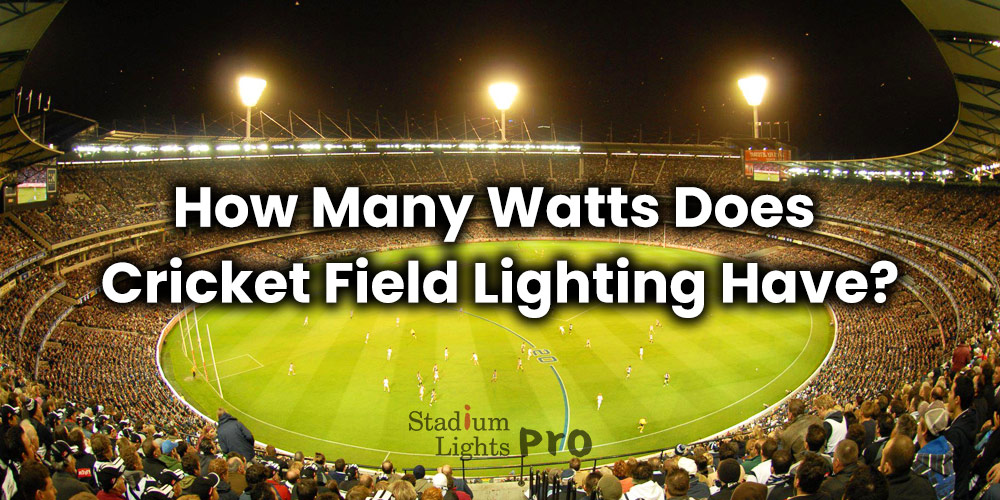Adequate illumination is essential to facilitate accurate gameplay and maintain the safety of participants. This article aims to explore the wattage requirements for cricket field lighting, considering various levels of competitions, from recreational to professional.
Table of Contents
ToggleRange of cricket stadium lighting wattage requirements
The wattage requirements for cricket field lighting can vary depending on the level of competition and the desired lighting standards. Here is a general range for different levels:
| Level | Field Size | Wattage Range |
|---|---|---|
| Recreational | Small-sized | 10,000 to 20,000 watts |
| Medium-sized | 30,000 to 50,000 watts | |
| Large-sized | 40,000 to 60,000 watts | |
| Amateur/Local Club | Small-sized | 25,000 to 50,000 watts |
| Medium-sized | 75,000 to 125,000 watts | |
| Large-sized | 100,000 to 150,000 watts | |
| Professional | Small-sized | 40,000 to 80,000 watts |
| Medium-sized | 120,000 to 200,000 watts | |
| Large-sized | 160,000 to 240,000 watts |
These ranges are approximate and can vary depending on factors such as lighting technology advancements and specific requirements of different cricket associations.
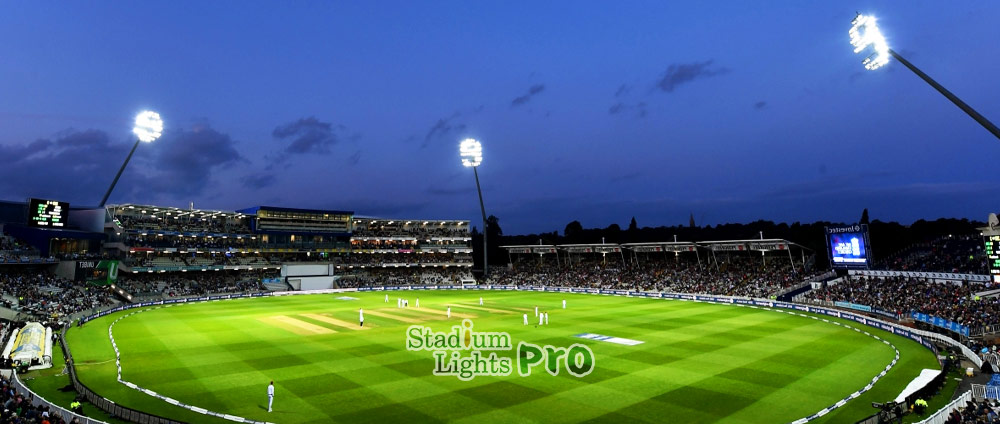
How to calculate wattage required for cricket field lights?
Let’s consider a standard cricket field with dimensions of 150 meters in length and 100 meters in width. To ensure uniform lighting across the entire field, we need to determine the appropriate wattage.
Calculate the cricket field’s total area
Total area = Length × Width
= 150 m × 100 m
= 15,000 square meters
Determine the recommended lighting level
The average recommended lighting level for a cricket field is approximately 200 lux. Lux is a unit that measures the amount of light falling on a surface.
Calculate the total illuminance required
Total illuminance = Recommended lighting level × Total area
= 200 lux × 15,000 square meters
= 3,000,000 lux·m²
Convert lux·m² to watts
Taking into account LED cricket stadium lights with an efficiency of 150 lumens per watt, the calculation for determining the required wattage is as follows:
The total illuminance required for the cricket field is 3,000,000 lux·m², as mentioned earlier.
To calculate the wattage required, we divide the total illuminance by the lumens per watt efficiency of the LED lights:
Wattage Required
= Total illuminance / Lumens per watt efficiency
= 3,000,000 lux·m² / 150 lumens per watt
= 20,000 watts
Therefore, based on the given efficiency of 150 lumens per watt for the LED cricket stadium lights, the wattage required for the field would be 20,000 watts.
Suggested reading: How much does it cost to run cricket stadium lights?
Factors affecting cricket field lighting watts
Several factors influence the lighting requirements for a cricket field. These include the field size, lighting layout, type of lighting fixtures, the height at which they are installed, and the level of competition taking place.
Field size
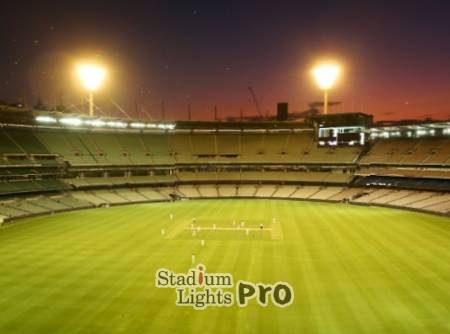 Larger fields naturally have a larger playing area that needs to be adequately illuminated for players and spectators.
Larger fields naturally have a larger playing area that needs to be adequately illuminated for players and spectators.
When considering the size of the cricket field, both length and width are essential factors. A larger field requires more lighting fixtures to achieve uniform illumination throughout the playing area. The lighting system must be designed to provide consistent lighting levels, ensuring that players can see the ball clearly and make accurate judgments.
Apart from the playing area, other areas around the field, such as the boundary, pavilion, and spectator stands, may also require illumination for safety and visibility purposes. These areas contribute to the overall size of the field and affect the wattage requirements.
Furthermore, larger fields often have a greater distance between the lighting fixtures and the playing surface. This increased distance necessitates stronger and more powerful lighting fixtures to compensate for light loss and maintain the desired illuminance levels on the ground.
To ensure uniform illumination across the entire playing area of a larger cricket field, higher wattage lighting fixtures or a larger number of fixtures may be required. Careful consideration must be given to the size of the field when designing the lighting system, taking into account the specific requirements and standards set by cricket associations or governing bodies.
By accurately assessing the size of the cricket field, lighting designers can determine the optimal wattage and layout for the lighting fixtures, resulting in appropriate illumination levels for players, officials, and spectators alike.
Lighting layout
Proper positioning, spacing, and angle of the lights contribute to achieving uniform lighting coverage and minimizing any potential dark spots or shadows on the field.
When planning the layout, lighting designers consider factors such as the field’s size, shape, and specific lighting standards. The goal is to ensure that every area of the playing surface receives adequate illumination, allowing players to see the ball clearly and make accurate judgments.
Positioning
The fixtures need to be positioned in a way that minimizes shadows and provides consistent lighting across the entire field. Placing fixtures at appropriate heights and angles helps prevent glare and ensures optimal visibility for players and officials.
Spacing
We could determine the right balance between fixture density and uniformity. If fixtures are spaced too far apart, it may result in uneven lighting and dark areas. Conversely, if fixtures are placed too close together, it can lead to excessive overlapping of light, which can cause glare and waste energy.
Angle
The fixtures should be angled in a way that directs the light downward, providing uniform illumination without excessive spillage or glare. This helps maximize visibility and minimize light pollution.
By carefully considering the layout of lighting fixtures, lighting designers can determine the appropriate wattage required to achieve the desired lighting levels. Optimal positioning, spacing, and angles can help minimize energy wastage, enhance player performance, and create a safe and visually comfortable environment for both players and spectators.
Moreover, advancements in lighting technology, such as adjustable fixtures and smart lighting controls, allow for further customization and flexibility in the lighting layout, enabling efficient energy usage while meeting the specific lighting requirements of the cricket field.
Type of lighting fixtures
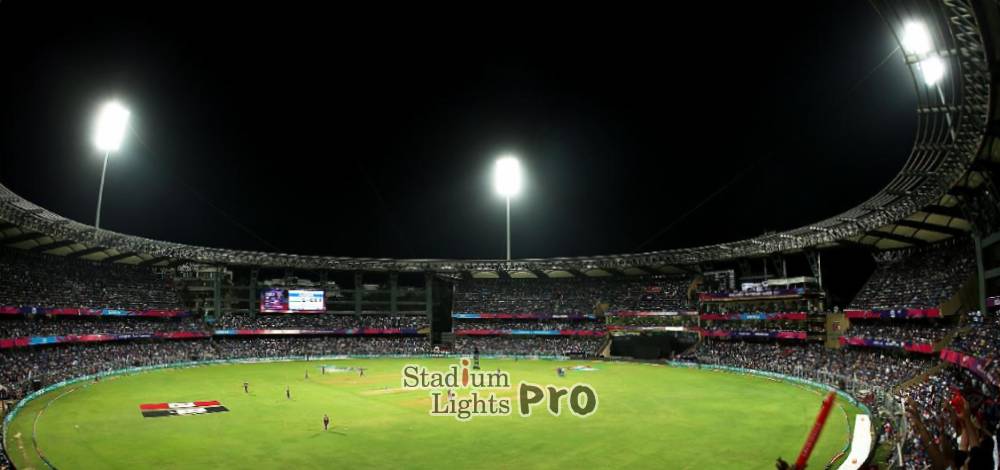
Different lighting technologies, such as metal halide, LED, or high-pressure sodium, offer varying levels of efficiency and energy consumption.
Metal halide fixtures have been traditionally used in sports lighting. They provide a bright and intense light output, making them suitable for illuminating large areas. However, they have relatively lower efficiency compared to LED fixtures, resulting in higher wattage requirements to achieve the desired lighting levels. Metal halide fixtures often require more power to produce the same amount of light output as LED fixtures.
High-pressure sodium (HPS) fixtures have been commonly used in outdoor lighting due to their long lifespan and warm-colored light. However, they are less efficient than LED fixtures, which means higher wattage is needed to achieve comparable illumination levels.
LED lighting fixtures have gained popularity in recent years due to their numerous advantages. LED technology offers higher energy efficiency, converting a greater portion of electrical energy into usable light. LED fixtures can produce the same or higher levels of illumination as traditional fixtures but with significantly lower wattage requirements. They are known for their long lifespan, durability, and better control over light distribution.
By adopting LED lighting fixtures on a cricket field, it is possible to achieve substantial energy savings and reduce operating costs. LED technology allows for precise lighting control, enabling lighting designers to meet the specific lighting requirements of the field while minimizing energy wastage.
When considering the wattage requirements for cricket field lighting, the choice of lighting technology plays a crucial role. LED lighting fixtures generally have lower wattage requirements compared to traditional options like metal halide or high-pressure sodium. This efficiency advantage makes LED fixtures an attractive choice for reducing energy consumption and optimizing the overall performance of the lighting system.
While the upfront cost of LED fixtures may be higher, the long-term energy savings and maintenance benefits make them a cost-effective and environmentally friendly solution for cricket field lighting.
Installation height
The installation height affects the distribution of light and the intensity of illumination at ground level.
When lighting fixtures are installed at higher heights, the light needs to travel a greater distance to reach the playing surface. As light spreads out, it can result in a decrease in intensity and uniformity. Therefore, higher installation heights often require more powerful fixtures to compensate for the light loss and provide sufficient illumination on the ground.
Fixtures installed at lower heights can provide more concentrated and intense lighting due to the shorter distance the light needs to travel. This may allow for lower wattage fixtures to achieve the desired lighting levels. However, it is necessary to strike a balance between the installation height and the type of fixtures used to ensure optimal illumination across the entire playing area.
Furthermore, the height of lighting fixtures is often influenced by factors such as the size and layout of the cricket field, the presence of obstacles, and the specific lighting standards set by cricket associations or governing bodies. Proper placement of lighting fixtures at an appropriate height helps minimize shadows, reduce glare, and maintain uniform illumination for players and officials.
By considering the height at which the lighting fixtures are installed, lighting designers can determine the wattage requirements to achieve the desired illuminance levels on the cricket field. We may select fixtures with the appropriate lumen output and beam angle to ensure sufficient light reaches the playing surface, regardless of the installation height.
Properly addressing the installation height factor ensures that the lighting system provides optimal visibility, enhances player performance, and ensures a safe and enjoyable experience for both players and spectators.
Level of competition
Higher-level competitions, such as professional matches, have specific lighting standards and regulations to ensure optimal visibility for players and viewers.
Professional cricket matches often require higher illuminance levels compared to recreational or amateur games. The increased illuminance ensures that players can track the ball accurately, make quick decisions, and perform at their best. It also enhances safety by reducing the risk of injuries caused by poor visibility.
To meet the illuminance requirements of professional matches, higher wattage lighting fixtures are often necessary. These fixtures provide a greater output of light to achieve the desired illuminance levels on the field. Higher wattage fixtures ensure that the playing area is evenly and brightly lit, leaving no room for shadows or dimly lit areas that could impact gameplay.
Moreover, professional cricket matches attract larger crowds and are often televised or live-streamed, requiring excellent visibility for spectators and viewers. Adequate lighting is crucial to capture the action on the field and provide an enjoyable viewing experience. Higher wattage lighting fixtures help ensure that the match is well-lit and visually appealing, enhancing the overall experience for viewers.
Lighting standards and requirements may vary depending on the cricket associations, governing bodies, or specific tournament regulations. These organizations often specify the minimum illuminance levels and uniformity requirements for different levels of cricket matches, including professional competitions. Compliance with these standards ensures fair gameplay and optimal visibility for all participants.
Considering the level of cricket being played is essential when designing the lighting system for a cricket field. The wattage requirements should be carefully determined to meet the specific illuminance needs of professional matches, balancing the demands of players, spectators, and broadcasting requirements. This ensures that the cricket field is appropriately illuminated to accommodate high-level gameplay and create a captivating experience for all involved.
Lighting standards and regulations
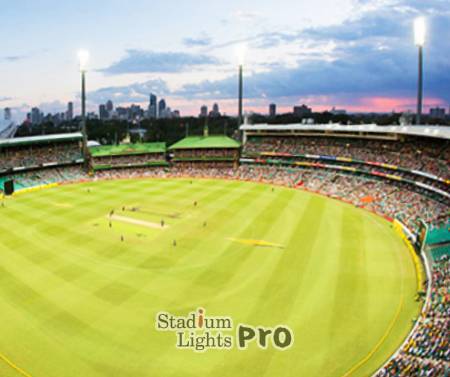 Cricket associations and governing bodies play a vital role in establishing lighting standards and regulations for cricket fields. These guidelines ensure that cricket matches are conducted under optimal lighting conditions, promoting fair play, player safety, and an enjoyable experience for participants and spectators alike.
Cricket associations and governing bodies play a vital role in establishing lighting standards and regulations for cricket fields. These guidelines ensure that cricket matches are conducted under optimal lighting conditions, promoting fair play, player safety, and an enjoyable experience for participants and spectators alike.
Specific lighting standards and regulations set by these organizations often include requirements for minimum lighting levels and uniformity across the playing surface. The purpose of these standards is to ensure that players have sufficient visibility to accurately track the ball, make informed decisions, and perform at their best.
The minimum lighting levels specified in the standards outline the minimum illuminance or brightness required on the field. This ensures that players can perceive the ball’s trajectory, judge its speed, and react effectively. The lighting levels are typically measured in lux, which represents the amount of light falling on a surface.
Aside from minimum lighting levels, the standards also emphasize the importance of uniformity. Uniformity refers to the consistency of lighting across the entire playing area. It ensures that there are no significant variations in brightness or shadows that could create visual obstacles for the players. Uniform lighting allows players to have a clear and consistent view of the field, promoting fair gameplay and reducing the risk of accidents or injuries.
Adhering to the lighting standards and regulations established by cricket associations or governing bodies is required when designing and installing lighting systems for cricket fields. These standards provide guidelines for lighting designers, specifying the necessary illuminance levels and uniformity requirements that must be met.
When determining the wattage needed for lighting the field, compliance with these standards is of utmost importance. The wattage requirements must align with the lighting levels and uniformity guidelines specified by the cricket associations or governing bodies. This ensures that the lighting system meets the required standards and provides a suitable environment for cricket matches at the respective level of play.
Environmental considerations
The presence of nearby buildings, trees, or other obstacles can affect the overall effectiveness of the lighting system by casting shadows and obstructing the distribution of light. As a result, higher wattage may be necessary to compensate for the loss of illumination caused by these environmental factors.
Shadows cast by nearby buildings or structures can create dark areas on the field, reducing visibility and potentially affecting gameplay. To counteract these shadows and maintain uniform lighting levels, higher wattage fixtures or supplementary lighting units may be required. By increasing the wattage, the lighting system can produce a higher output of light to overcome the shadowing effects and ensure consistent illumination across the playing area.
Similarly, the presence of trees or other vegetation near the cricket field can cause obstructions and create uneven lighting conditions. Foliage can block or scatter the light, resulting in areas of reduced illumination. In such cases, higher wattage fixtures or adjustments to the lighting layout may be necessary to compensate for the loss of light caused by these obstacles.
Furthermore, the angle and direction of light emitted by the fixtures can be adjusted to minimize the impact of shadows and obstacles. Lighting designers can strategically position the fixtures or use specialized optics to redirect the light and mitigate the effects of environmental obstructions.
When assessing the wattage requirements for cricket field lighting, we could consider the specific environmental factors present in the surrounding area. Conducting a thorough site analysis helps identify potential obstacles that may interfere with the distribution of light. By taking these factors into account, lighting designers can determine the appropriate wattage and optimize the lighting system to overcome the challenges posed by the environment.
Maintenance factors
By implementing regular cleaning, bulb replacements, and proper fixture maintenance, it is possible to maximize the efficiency of the system and potentially reduce the need for higher wattage.
Regular cleaning of the lighting fixtures helps to remove accumulated dirt, dust, and debris. Over time, these contaminants can block or reduce the output of light, leading to decreased illuminance levels on the field. By maintaining clean fixtures, the light can shine through unimpeded, allowing for optimal illumination without the need for excessive wattage.
What is more, proper maintenance includes periodic bulb replacements. Light bulbs, especially in traditional lighting technologies, have a limited lifespan and tend to gradually decrease in brightness over time. When bulbs start to dim or fail, the lighting system may require higher wattage to compensate for the reduced output. By promptly replacing bulbs at the end of their lifespan, the lighting system can maintain the desired illuminance levels without the need for extra wattage.
Furthermore, fixture maintenance is essential for ensuring the proper functioning of the lighting system. This includes inspecting and repairing any damaged or malfunctioning fixtures, as well as verifying the alignment and positioning of the fixtures for optimal light distribution. Faulty fixtures or misaligned lighting can result in uneven illumination, potentially necessitating higher wattage to compensate for the deficiencies. By conducting regular maintenance checks and addressing any issues promptly, the lighting system can operate efficiently and effectively at lower wattage levels.
By implementing a comprehensive maintenance program for the lighting system, the overall performance can be optimized, potentially resulting in reduced wattage requirements. Regular cleaning, bulb replacements, and proper fixture maintenance contribute to maintaining consistent illuminance levels, reducing the impact of lighting degradation over time, and prolonging the lifespan of the lighting system.
Efficient maintenance practices not only enhance the lighting system’s performance but also help minimize energy consumption and operating costs. By ensuring that the system operates at its optimal efficiency, cricket field operators can maintain adequate lighting levels while minimizing the need for higher wattage or unnecessary energy expenditure.
Conclusion
When it comes to cricket field lighting, ensuring appropriate wattage is crucial for optimum visibility and gameplay. The wattage requirements vary based on the level of competition, field size, and other factors. By considering the recommended lighting level and performing simple calculations, the wattage needed for any cricket field can be determined, allowing for an enjoyable and safe playing experience for both players and spectators alike.
For a comprehensive and customized cricket field lighting design, feel free to contact us. Our team of experts can provide you with a free consultation and help determine the specific wattage requirements for your cricket ground. We understand the importance of proper lighting in enhancing gameplay, ensuring player safety, and creating a captivating experience for spectators.
By leveraging our expertise in lighting design and industry standards, we can develop a tailored solution that meets your specific needs. Whether you’re organizing recreational matches, professional competitions, or any other level of cricket, we can guide you through the process and recommend the appropriate wattage for your lighting system.
Our team takes into account various factors such as field size, layout, level of competition, environmental conditions, and lighting regulations to ensure optimal results. We understand that each cricket field has unique requirements, and our goal is to deliver a lighting solution that maximizes visibility, minimizes energy consumption, and offers long-term cost savings.
Don’t hesitate to reach out to us today to get started. Take advantage of our expertise and experience in cricket field lighting design. We’re here to assist you in determining the ideal wattage for your cricket ground and to provide you with a lighting solution that meets your specific requirements. Contact us now for your free cricket field lighting design consultation.

